Earlier this month friends gathered a group of us together for dinner at their house. It just so happened that our friend, Genevieve S, was celebrating a birthday that day. Earlier this year we had vowed to only exchange gifts on milestone birthdays. That vow wasn’t going to stop me from making her a cake.
As much as I love a good chocolate cake, I decided that lemon was the way to go for this special cake. Genevieve and I share a love of lavender, so I thought maybe I could work some of that in, too.
I had fun looking at a lot of different lemon cake recipes. I landed on one from Julee Rosso and Sheila Lukins’ The Silver Palate (1979) because pretty much every recipe from this cookbook that I’ve ever made has been good. This recipe was simple but had all of the right ingredients. To ensure that the cake had a strong lemon flavor, I zested the lemons a day in advance and mixed the zest into the granulated white sugar. The zest contains the oil from the lemon and the sugar absorbs that oil well. If you don’t remember to do this step, no worries as the cake will still be yummy. I also added a few teaspoons of culinary lavender buds to the batter. I used King Arthur Organic All-Purpose Flour, which is also non-GMO, for this cake. I have not tried it with gluten-free flour.
I actually found the frosting recipe before I found the cake recipe. It came from a much more recent cookbook, Yotam Ottolenghi and Helen Goh’s Sweet: Desserts from London’s Ottolenghi (2017). Once again, it’s hard to go wrong with any recipes from Ottolenghi so I knew that I was in good hands. This recipe calls for homemade lemon curd but you can substitute a good store-bought version. However, I recommend trying your hand at making it from scratch as it’s pretty easy and it tastes so good. In fact, plan to double the recipe so you have some extra on hand for muffins, toast or pancakes.
Once you have the lemon curd ready, you whip it with mascarpone cheese. I added a few teaspoons of culinary lavender extract (available online) to continue the lavender theme. It provides a subtle floral flavor to accompany the lemon. Don’t worry as the frosting is just as good without the lavender extract. In fact, this is one the best frostings I’ve ever had. It’s so versatile and easy to prepare (especially if you use pre-made lemon curd), it might just become your favorite frosting.
When the cake is cooled, spread the yummy frosting all over. Added bonus – the frosting will hide any imperfections in your cake. I was fortunate that our hosts had plenty of fresh lavender growing in their yard (mine was already past its prime), so I used some fresh lavender flowers to decorate this amazing cake. If you don’t have fresh lavender on hand, you can sprinkle some culinary lavender on top of the cake. Once you’ve frosted the cake, store it in the refrigerator and take it out about 30 minutes prior to serving.
The cake was a hit all around including with Genevieve. The cake was very moist and the frosting had just the right amount of creaminess and tartness and isn’t too sweet. I will definitely be making this again soon as I’m dreaming about how good it is as I write this post.
| Lemon-Lavender Cake with Mascarpone Frosting | | Print |
- 2 cups granulated white sugar
- 2 tightly packed tablespoons lemon zest (~ 2 lemons – save lemons for juice) (see Notes)
- 2 sticks (1 cup) unsalted butter, softened
- 3 eggs
- 3 cups all-purpose flour, sifted
- ½ teaspoon baking soda
- ½ teaspoon Kosher salt
- 1 cup buttermilk (see Notes)
- 2 tablespoons fresh lemon juice (~ 2 lemons) (see Notes)
- 2 teaspoons dried culinary lavender buds
- 1 large egg, plus 2 large egg yolks
- 3 ounces freshly squeezed lemon juice (~ 2 lemons) (see Notes)
- ⅓ cup plus 1 tablespoon granulated white sugar
- 5 tablespoons plus 1 teaspoon unsalted butter, at room temperature, cut into ¾-inch cubes
- 16 ounces mascarpone cheese
- 1 cup lemon curd (see Notes)
- 2 teaspoons lavender extract (optional) (see Notes)
- For garnish: fresh lavender flowers or dried culinary lavender buds
- To increase the lemon flavor of the cake, 24 hours prior to preparing the cake, place sugar and lemon zest in a bowl. Mix with a fork until lemon zest is incorporated into sugar. Cover with plastic wrap and store at room temperature. (If you don’t have time to do this step, add the lemon zest with the lemon juice in the last step.)
- Preheat the oven to 325°F. Grease a 10-inch tube pan (like one used for Angel Food Cake). Wrap the bottom of the pan in two sheets of aluminum foil to avoid some of the batter oozing out in the oven. Set aside.
- Using a stand mixer or handheld mixer, cream the butter and sugar until light and fluffy on high speed, about 3 minutes.
- Add the eggs, one at a time, blending well on medium speed after each addition.
- Sift together flour, baking soda and salt.
- On low speed, stir the dry ingredients into the egg mixture alternately with the buttermilk, beginning and ending with the dry ingredients. Add the lemon juice, lemon zest (if you didn’t add it to the sugar) and lavender buds.
- Pour batter into the prepared tube pan. Set on the middle rack of the oven and bake for 60 to 70 minutes, or until the cake pulls away from the sides of the pan and a tester inserted in the center comes out clean.
- Cool cake in the pan, set on a wire rack, for 10 minutes. Remove cake from pan and cool completely before frosting. Don't worry if the cake doesn't look perfect coming out of the pan as the frostng will cover up any imperfections.
- While the cake is cooling, prepare the lemon curd. (Alternatively, lemon curd can be prepared 24 hours in advance.)
- In a medium bowl, whisk together the whole egg and egg yolks and set aside.
- Combine the lemon juice and sugar in a small saucepan and place over medium-high heat. Stir until the sugar dissolves.
- As soon as it comes to a boil, pour the syrup over the eggs, whisking continuously.
- Return the mixture to the saucepan and cook over low heat for 4 to 5 minutes, stirring constantly with a wooden spoon until the mixture has thickened and one or two bubbles appear on the surface.
- Remove pan from heat and stir in the butter, one cube at a time, waiting until each piece melts before adding the next.
- When all the butter has melted and the mixture is smooth, transfer the curd to a clean container and cover the surface with plastic wrap – you want the plastic wrap to actually touch the surface to prevent it from forming a skin. Set aside to cool completely before placing in the refrigerator until needed. Makes 1 cup.
- Using a stand mixer or handheld mixer, place the lemon curd, mascarpone and lavender extract (if using) in the bowl with the whisk attachment in place. Beat on medium speed until thick, about 1 minute.
- Use a small spatula or butterknife to frost the top and sides of the cake.
- For garnish, top with fresh lavender flowers or dried culinary lavender buds.
- Store frosted cake (covered) in the refrigerator. Take out 30 minutes prior to serving.
- Cake can be prepared and frosted one day in advance.
* For this recipe, you want fine lemon zest which is best achieved by using a microplane.
* You need 4 to 5 total lemons for this recipe if you’re preparing both the cake and lemon curd. Before squeezing lemons, heat it in a microwave for about 20 seconds and then rub it back and forth on the counter top. This easy two-step process results in more juice per piece of fruit.
* I recommend using SACO Cultured Buttermilk Blend in place of fresh buttermilk. You’ll find it in the baking section of your grocery store. Follow directions on the container for use. It keeps for a few years refrigerated so you always have buttermilk on hand.
* You can find culinary lavender extract on Amazon.
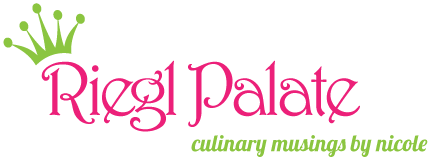

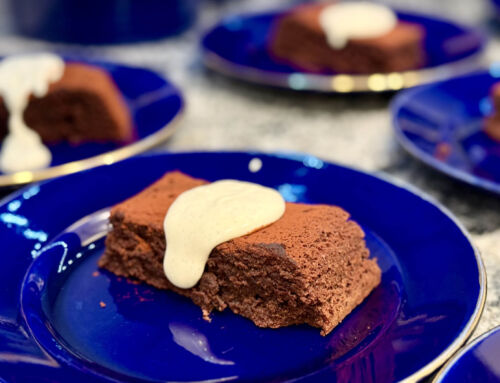
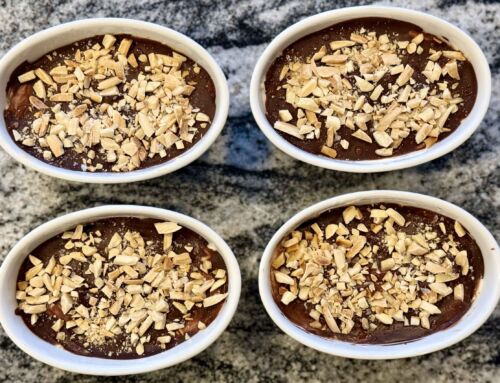
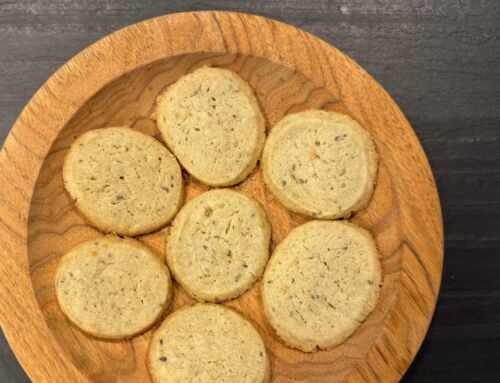
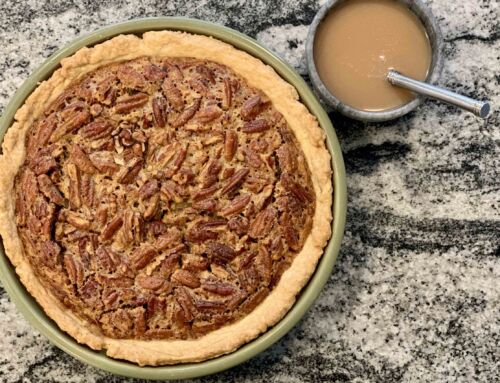
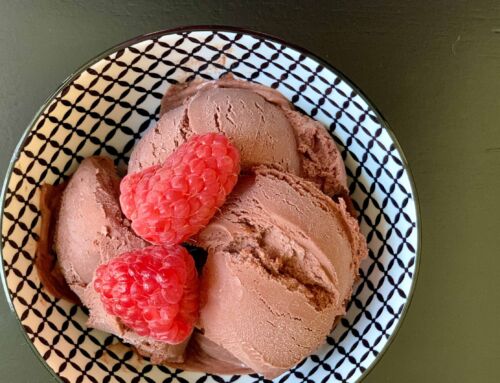
This looks heavenly!
Spenser – Thank you! A great description for this cake.
Funny, I have both of those books and never noticed either recipe. I’d love what you’ve done with them by adding lavender, and mixing the two recipes. Definitely one I will try… Maybe for MY birthday!
P. S. I have never heard of the cultured buttermilk blend, but I will be looking for it. Whenever I need buttermilk and don’t have any, I simply sour milk or cream by adding vinegar or lemon juice. That’s a trick my mother taught me, and yours probably did you, as well.
David – I am aware of the buttermilk trick but have actually never tried it (my mother wasn’t much of a baker!). I’ve been using the dried blend for years and have never had a problem with it. It’s keeps for a long time, too.
David – I am not at all surprised that both of these books are in your library! I know this is the perfect birthday cake for you.